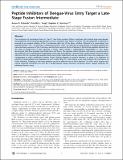| dc.contributor.author | Schmidt, Aaron Gregory | |
| dc.contributor.author | Yang, Priscilla | |
| dc.contributor.author | Harrison, Stephen C. | |
| dc.date.accessioned | 2010-10-06T19:45:20Z | |
| dc.date.issued | 2010 | |
| dc.identifier.citation | Schmidt, Aaron G., Priscilla L. Yang, and Stephen C. Harrison. 2010. Peptide Inhibitors of Dengue-Virus Entry Target a Late-Stage Fusion Intermediate. PLoS Pathogens 6(4): e1000851. | en_US |
| dc.identifier.issn | 1553-7366 | en_US |
| dc.identifier.uri | http://nrs.harvard.edu/urn-3:HUL.InstRepos:4460803 | |
| dc.description.abstract | The mechanism of membrane fusion by “class II” viral fusion proteins follows a pathway that involves large-scale domain rearrangements of the envelope glycoprotein (E) and a transition from dimers to trimers. The rearrangement is believed to proceed by an outward rotation of the E ectodomain after loss of the dimer interface, followed by a reassociation into extended trimers. The ∼55-aa-residue, membrane proximal “stem” can then zip up along domain II, bringing together the transmembrane segments of the C-terminus and the fusion loops at the tip of domain II. We find that peptides derived from the stem of dengue-virus E bind stem-less E trimer, which models a conformational intermediate. In vitro assays demonstrate that these peptides specifically block viral fusion. The peptides inhibit infectivity with potency proportional to their affinity for the conformational intermediate, even when free peptide is removed from a preincubated inoculum before infecting cells. We conclude that peptides bind virions before attachment and are carried with virions into endosomes, the compartment in which acidification initiates fusion. Binding depends on particle dynamics, as there is no inhibition of infectivity if preincubation and separation are at 4°C rather than 37°C. We propose a two-step model for the mechanism of fusion inhibition. Targeting a viral entry pathway can be an effective way to block infection. Our data, which support and extend proposed mechanisms for how the E conformational change promotes membrane fusion, suggest strategies for inhibiting flavivirus entry. | en_US |
| dc.description.sponsorship | Molecular and Cellular Biology | en_US |
| dc.language.iso | en_US | en_US |
| dc.publisher | Public Library of Science | en_US |
| dc.relation.isversionof | doi:10.1371/journal.ppat.1000851 | en_US |
| dc.relation.hasversion | http://www.ncbi.nlm.nih.gov/pmc/articles/PMC2851732/pdf/ | en_US |
| dash.license | OAP | |
| dc.subject | biochemistry | en_US |
| dc.subject | drug discovery | en_US |
| dc.subject | protein chemistry | en_US |
| dc.subject | virology | en_US |
| dc.subject | antivirals, including modes of action and resistance | en_US |
| dc.subject | emerging viral diseases | en_US |
| dc.subject | new therapies, including antivirals and immunotherapy | en_US |
| dc.title | Peptide Inhibitors of Dengue-Virus Entry Target a Late-Stage Fusion Intermediate | en_US |
| dc.type | Journal Article | en_US |
| dc.description.version | Version of Record | en_US |
| dc.relation.journal | PLoS Pathogens | en_US |
| dash.depositing.author | Harrison, Stephen C. | |
| dc.date.available | 2010-10-06T19:45:20Z | |
| dc.identifier.doi | 10.1371/journal.ppat.1000851 | * |
| dash.contributor.affiliated | Schmidt, Aaron | |
| dash.contributor.affiliated | Yang, Priscilla | |
| dash.contributor.affiliated | Harrison, Stephen | |


